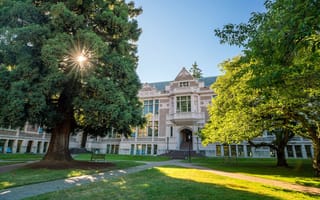University of Washington assistant professor Jevin West knows BS when he sees it.
With a background in physics and biology, West has devoted his research skills to the university’s Information School, where he co-teaches a course titled “Calling Bullshit.”
In each class, students examine the memes, fake news stories and misleading scientific studies they encounter in their everyday lives. West then shows them how to parse the false claims and pseudoscientific studies from the real ones, and arms them with the tools necessary to debunk them.
Now, West will be tackling BS on a national level as the inaugural director of The Center for an Informed Public at the University of Washington, founded with a $5 million grant from the Knight Foundation. West will be joined by four other researchers who will help the public develop strategies to recognize and combat fake news.
As technology warps the speed at which news is shared and amplifies the ability for people to manipulate it, discerning between fact and fiction is becoming more and more difficult.
“We see this information epidemic as one of the most pressing problems of our time,” West said. “It hits every industry, and anyone who engages with information online and offline. We need to bring legal scholars, policymakers, tech leaders, librarians and journalists to the table, and the Center will be that place.”

How social media propelled fake news into the mainstream
Fake news dates as far back as the first days of printing, with perhaps the most famous example being the Great Moon Hoax of 1835, in which the New York Sun claimed to have seen evidence of a civilization on the moon. See also: The trove of “sources” most 9/11 truthers and Moon landing deniers cite. But for a long time, modern fake news stories have been relegated to the dark corners of the web and on discredited sites like Infowars and Next News Network.
That’s all changed, however, with the rise of social media. On websites like Facebook and Twitter, a simple “Like” or Retweet can cause disinformation to spread like wildfire. On YouTube, an algorithmic tweak designed to expose viewers to a broader variety of videos inadvertently favored extremist and conspiracy videos instead, according to the Huffington Post.
We see this information epidemic as one of the most pressing problems of our time.”
Those platforms have allowed fake stories, like those claiming Hillary Clinton sold guns to ISIS or furthering the Pizzagate conspiracy, to enter mainstream dialogue. Recently, doctored videos of House Speaker Nancy Pelosi that made her appear drunk made the rounds, and one of them was even shared by President Donald Trump on Twitter. On WhatsApp, fake stories about kidnappings in India have led to mob violence and lynchings, according to Wired.
How widespread is fake news, really?
In total, about 60 percent of Americans come across fake news on social media websites, according to a study from Pew Research Center. Part of what makes them tricky to spot is that these false stories mimic real news, and that some publishers use knockoff domains like ABCnews.com.co or KMT11.com to trick readers. Meanwhile, the narratives and rumors those stories peddle are more persuasive and memorable than real facts are, according to Poynter.
So just how big of a problem is it? Americans ranked fake news as a bigger problem than violent crime, immigration and climate change, according to the Pew study. Add in the rise of deepfake technology, which allows users to swap out faces and make famous people appear to say or do whatever they want in videos, and the future looks bleak.
If [students] hear ‘Chocolate is good for me’ based on a study in Southern Italy, they don’t know where to go to check the source.”
But it’s not all doom and gloom. Other studies have been more conservative on the impact of fake news. One study published in Science found that only 1 percent of users on Twitter were exposed to 80 percent of fake news, and that it was most concentrated among conservative voters.
Inside West’s classroom, students struggle less with political news and more with scientific studies making false or misinformed claims.
“If they hear ‘Chocolate is good for me’ based on a study in Southern Italy, they don’t know where to go to check the source,” West said. “They do well with political news because they have their radar on.”
(Sorry, chocolate lovers: There is no conclusive evidence about whether eating chocolate is good for you or not, according to the American Cancer Society).
Those studies, however, can be just as dangerous as political news, West said. False studies claiming vaccinations cause harmful effects have catalyzed the resurrection of measles.
Ultimately, the Pew study found that 56 percent of Americans believe the fake news problem will only get worse in the next five years, and solutions have been slow to come. Facebook is working to stem the spread of fake news on its platform, but it has yet to find a silver bullet solution. And YouTube’s algorithm tweak to reduce conspiracy videos is flailing, according to the Huffington Post.
It’s clear that stemming the spread of fake news will take more than a simple tweak.

Inside UW’s mission to inform the public
That’s the challenge facing The Center at the University of Washington.
The school will join a network of four other universities that received grants from the Knight Foundation to explore how technology has changed the way we consume and spread information. The foundation calls the shift to a digital public square the biggest change in communication since the printing press, and it seeks to understand how that impacts our democracy through research.
Each school will focus on the challenge from a different angle, ranging from examining digital media’s impact on national dialogue to the role of social media and the spread of fake news. University of Washington’s unique focus will be on how misinformation and disinformation spreads, how it influences beliefs, and how researchers, policymakers and librarians can cultivate a more informed society.
The school’s location in the backyard of Silicon Valley, existing relationship with libraries and experience researching fake news made it an ideal candidate to become a hub, West said.
Despite all of this new tech that’s making it more difficult to determine what’s real and what’s not, we can still rely on basic tools for spotting BS.”
Two UW researchers have been studying how rumors spread through social media since before fake news became a buzzword in 2016. Another researcher has been exploring technology policy and laws like Section 230, which gives tech companies immunity from facing liability for the community-generated content that is shared on their websites.
“We’re a public university, and we have a public mission, and we see this as a public project,” West said. “It’s bigger than just an individual research center.”
But while technology has accelerated the spread of fake news, we don’t necessarily have to rely on big tech to solve it. West’s biggest takeaway for his students is that they can debunk any misleading scientific study or false story using a healthy dose of skepticism, deploying some critical reading skills and fact-checking against other stories.
“We are contending with new technologies all the time, making it more difficult to identify what’s fake and what’s not,” West said. “Despite all of this new tech that’s making it more difficult to determine what’s real and what’s not, we can still rely on basic tools for spotting BS.”
A good starting point is to always be asking a few basic questions:
- Who is the source?
- What do they know?
- What can they gain from the story?
- Is the information too good to be true?
But to say that critical reading is the solution to the information age’s fake news problem would be too simple and neat. Even West is duped by stories thanks to his own confirmation bias from time to time.
If there’s any hope in stemming the tide of fake news, it’ll require all stakeholders — libraries, researchers, tech companies and the public — working together. And that’s what West and his colleagues hope to accomplish at the Center.
“I don't think we can just solve fake news,” West said. “It will always be there. But hopefully we can contain it and reduce its ill effects on society.”




